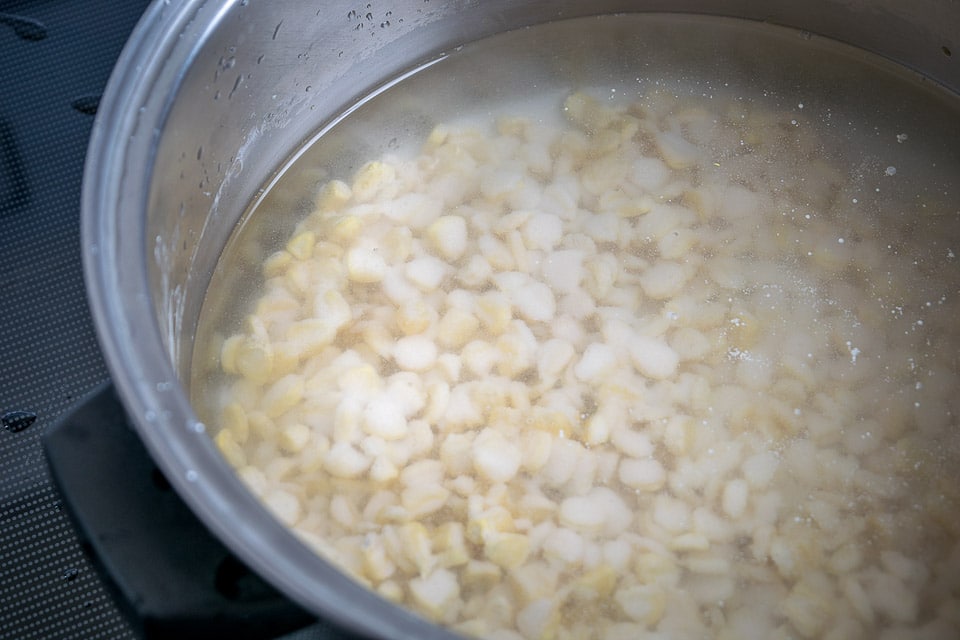So what exactly is Nixtamal? And do I really need to make nixtamal if I want some authentic corn tortillas?
Good question!
Let's start by taking a closer look at the nixtamalization process. We'll start with 2 cups of dried White Olotillo Corn.
If you grind up this corn and make some tortillas from it you're going to be disappointed -- they won't taste like tortillas to you!
But if you soak this corn in an alkaline solution then lots of good things will happen. Among them:
The corn becomes easier to grind up.
The nutritional content will increase, specifically the niacin and calcium levels.
And most importantly, it'll taste better!
Nobody knows for sure how the ancient Mesoamericans discovered this process, but wood ashes are highly alkaline so that could be a telling clue.
These days it's most common to use calcium hydroxide as the alkaline agent. You'll frequently see it referred to as Cal, Pickling Lime, or slaked lime. It's a white, odorless powder that works wonders on dried corn. (What is Calcium Hydroxide?)
After giving the corn a good rinse, we'll add 1 tablespoon of the calcium hydroxide to a non-reactive saucepan (I used stainless steel) along with 7-8 cups of water. Give it a good stir and then add the corn.
We'll bring this to a boil and then reduce the heat so it is just simmering.
It’ll need about 20-30 minutes until the outer layer of the corn is cooked and the pericarp slides off easily.
If you take a bite of this kernel the outer layer will be cooked but the inside will be white and starchy -- that's how you want it, you don't need to cook it all the way through.
Remove the pan from the heat and cover. Confirm that the corn is completely submerged by the liquid; if not you can add some more cold water.
Let this mixture rest overnight at room temperature -- this will give the calcium hydroxide time to work its magic!
After resting overnight, you can drain the corn and discard the soaking liquid.
Run the corn under some cold water and use your hands to slide off the outer skins of the kernels. Most of them will fall off quite easily. I usually rinse the corn until the water starts to run clear.
And that, my friends, is nixtamal! Corn soaked in an alkaline solution that's ready and willing to become hominy, masa dough, tamales or corn tortillas.
Ground nixtamal is typically referred to as masa (or masa dough). Here's what the masa looks like in the markets of Cozumel.

Photo by Chloe Miller
In the background of that photo you can spot the industrial grinder they use to grind the corn into dough that's fine enough for corn tortillas.
That's the primary obstacle when using nixtamal at home -- grinding it down can be a pain to do by hand, and most peeps don't have access to stone grinders.
A workaround is to use a food processor to grind the nixtamal:
You can see how to do this in our White Olotillo Corn Tortillas post. You have to add water to get the corn to grind down, thus ending up with some wet masa dough. Adding some Masa Harina back into the mixture will give you the right consistency.
Speaking of Masa Harina, you may have come across bags of it in your local supermarkets as it's become more popular in the States.
Mexican producers will grind nixtamal into masa dough and then dehydrate it so that you get powdered corn flour. Simply add water to this corn flour and just like that you've got some masa dough on your hands!
But truth be told, tortillas made from Masa Harina won't be as good as the ones you make from freshly ground nixtamal!
Okay, that wraps up the nixtamal tutorial. I'll put some links below that will provide recipes if you want to try any of this at home.
Homemade Corn Tortillas using Masa Harina
Homemade Masa Dough using yellow field corn
Corn Tortillas (and Nixtamal) Made With White Olotillo Corn
Feel free to email me if you have any other questions about the world of nixtamal!
Still hungry?!
Want to receive Mexican Please recipes via email when they are posted? Sign up below to subscribe. All recipes are spam free.









